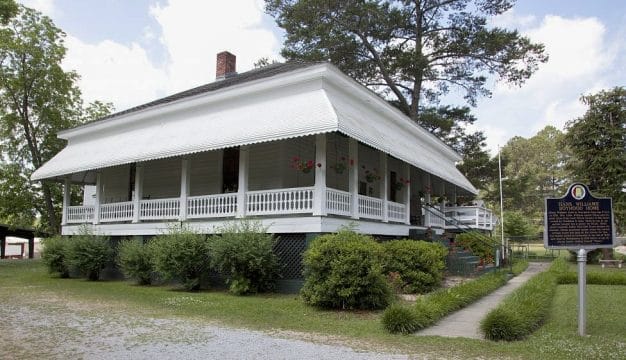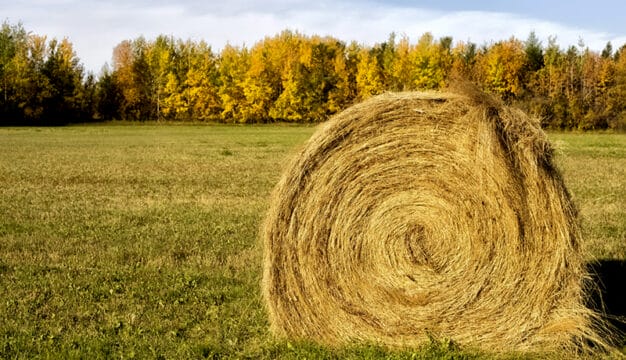Alabama Ginger
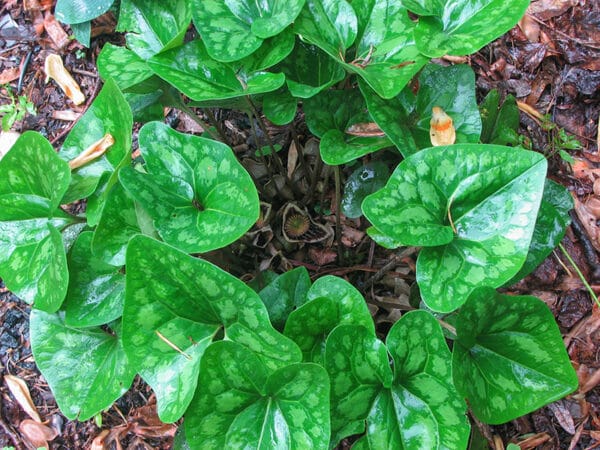 Alabama Ginger
Alabama ginger (Hexastylis speciosa) is a species of native ginger known only from a small area in central Alabama. Here, it thrives in low, floodplain woods near swift, sand-bottomed, spring-fed creeks, often just below specialized ecological communities called seepage bogs. These “seepage bogs” are steep, sandy slopes with an impervious rock layer embedded in them; as a result, water continually seeps out of the hillside, creating a microenvironment suitable for bog and wetland plants, such as the endemic canebrake pitcher plant. Like other members of its family, the Aristolochiaceae, or birthwort family, wild gingers possess unique, vase-shaped, and colorfully marked flowers. Alabama ginger’s genus name comes from the Greek for “six stigmas,” and the species name alludes to its particularly showy flowers, considered to be one of the showiest of the genus. This species may also prove to be one of the rarest wild gingers, known only from a small geographic range encompassing fewer than 20 populations within Autauga, Chilton, and Elmore Counties. As a result of its rarity, Alabama ginger is considered “at risk” by federal and state authorities and is currently being evaluated for federal listing under the U.S. Endangered Species Act, an action that would afford it much needed conservation protection.
Alabama Ginger
Alabama ginger (Hexastylis speciosa) is a species of native ginger known only from a small area in central Alabama. Here, it thrives in low, floodplain woods near swift, sand-bottomed, spring-fed creeks, often just below specialized ecological communities called seepage bogs. These “seepage bogs” are steep, sandy slopes with an impervious rock layer embedded in them; as a result, water continually seeps out of the hillside, creating a microenvironment suitable for bog and wetland plants, such as the endemic canebrake pitcher plant. Like other members of its family, the Aristolochiaceae, or birthwort family, wild gingers possess unique, vase-shaped, and colorfully marked flowers. Alabama ginger’s genus name comes from the Greek for “six stigmas,” and the species name alludes to its particularly showy flowers, considered to be one of the showiest of the genus. This species may also prove to be one of the rarest wild gingers, known only from a small geographic range encompassing fewer than 20 populations within Autauga, Chilton, and Elmore Counties. As a result of its rarity, Alabama ginger is considered “at risk” by federal and state authorities and is currently being evaluated for federal listing under the U.S. Endangered Species Act, an action that would afford it much needed conservation protection.
Hexastylis are termed wild gingers because all parts of the plant are spicy and sweet scented when crushed, reminiscent of culinary ginger. Native gingers have been used by indigenous peoples as a medicinal herb, with the roots of plants being steeped to make a tea for use as a diuretic and stimulant, like caffeine. All wild gingers, including Alabama ginger, contain aristolochic acid, a toxic compound, which has been linked to kidney damage in high doses. Consuming Alabama wild ginger unless under the guidance of a trained and experienced herbalist is highly discouraged given its overall rarity, as well as for its potentially harmful side effects.
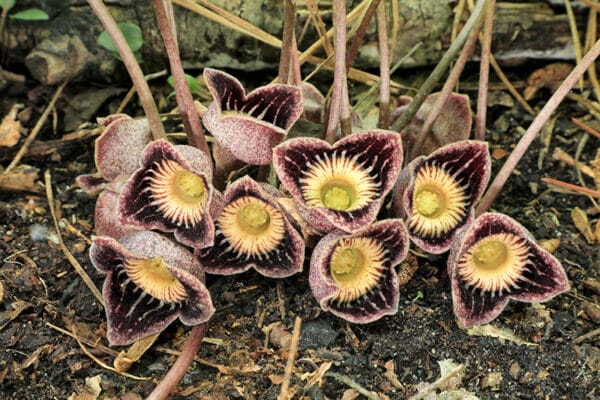 Alabama Ginger Flowers
Roland M. Harper, staff botanist for the Geological Survey of Alabama, first discovered Alabama ginger near Booth, Autauga County, in May 1924 while exploring a sandy floodplain near a tributary of Bridge Creek. He immediately recognized that the species was unlike any other wild ginger known at the time and described its habitat as an area where steep, sandy hills and slopes met fertile, floodplain woods. Alabama ginger’s range is within the Fall Line Hills, part of the broader East Gulf Coastal Plain physiographic section. This area is characterized by its abundance of longleaf pine, steep, sloping ravines, sandy spring-fed creeks, and a historic presence of low-intensity and high-frequency wildfires. Plant conservation scientists and Hexastylis researchers have proposed that Alabama ginger may need low-intensity prescribed fire in order to thrive and successfully reproduce, as these low floodplain habitats often accumulate organic matter that may prevent seedlings from reaching adulthood.
Alabama Ginger Flowers
Roland M. Harper, staff botanist for the Geological Survey of Alabama, first discovered Alabama ginger near Booth, Autauga County, in May 1924 while exploring a sandy floodplain near a tributary of Bridge Creek. He immediately recognized that the species was unlike any other wild ginger known at the time and described its habitat as an area where steep, sandy hills and slopes met fertile, floodplain woods. Alabama ginger’s range is within the Fall Line Hills, part of the broader East Gulf Coastal Plain physiographic section. This area is characterized by its abundance of longleaf pine, steep, sloping ravines, sandy spring-fed creeks, and a historic presence of low-intensity and high-frequency wildfires. Plant conservation scientists and Hexastylis researchers have proposed that Alabama ginger may need low-intensity prescribed fire in order to thrive and successfully reproduce, as these low floodplain habitats often accumulate organic matter that may prevent seedlings from reaching adulthood.
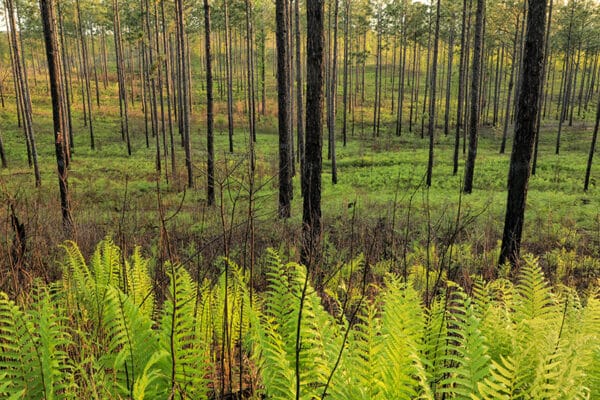 Fall Line Hills
Many wild gingers have been given common names such as “heartleaf,” “little brown jugs,” and “little pigs” as a reference to their interesting flowers and recognizable heart-shaped leaves. Wild gingers all possess evergreen leaves, often with a white mottled patterning on the surface. In late April and early May, vase-like flowers emerge and are quickly pollinated and produce seed in a short period of time. Alabama ginger flowers lack true petals and instead are made of fused sepals, termed a calyx, often with purple, red, and ivory markings inside. Although scientists do not know what the pollinator of wild gingers is, some of them speculate that ants, slugs, or other crawling and ground-dwelling insects may be responsible. Their flower coloration is quite unconventional when compared to other wildflowers. Many plants have evolved showy, brightly colored flowers full of nectar to attract bees, butterflies, and hummingbirds for pollination, but Alabama ginger and other wild gingers have flowers with red and dark purple coloration and fuzzy textures to possibly mimic carrion, or decaying meat, to attract ground-dwelling insects. After pollination, each flower quickly ripens to produce fleshy seeds. After flowering, wild gingers remain as an understory plant, spreading by creeping, horizontal underground stems, or rhizomes, that form clumps of plants over time.
Fall Line Hills
Many wild gingers have been given common names such as “heartleaf,” “little brown jugs,” and “little pigs” as a reference to their interesting flowers and recognizable heart-shaped leaves. Wild gingers all possess evergreen leaves, often with a white mottled patterning on the surface. In late April and early May, vase-like flowers emerge and are quickly pollinated and produce seed in a short period of time. Alabama ginger flowers lack true petals and instead are made of fused sepals, termed a calyx, often with purple, red, and ivory markings inside. Although scientists do not know what the pollinator of wild gingers is, some of them speculate that ants, slugs, or other crawling and ground-dwelling insects may be responsible. Their flower coloration is quite unconventional when compared to other wildflowers. Many plants have evolved showy, brightly colored flowers full of nectar to attract bees, butterflies, and hummingbirds for pollination, but Alabama ginger and other wild gingers have flowers with red and dark purple coloration and fuzzy textures to possibly mimic carrion, or decaying meat, to attract ground-dwelling insects. After pollination, each flower quickly ripens to produce fleshy seeds. After flowering, wild gingers remain as an understory plant, spreading by creeping, horizontal underground stems, or rhizomes, that form clumps of plants over time.
Similar to some other spring wildflowers, Alabama ginger and other wild gingers possess a special structure on the outside of each seed, termed an elaiosome, that is rich in fats and sugars. This structure offers an energy-rich food incentive for native ants, which often transport the seed to a more favorable location for germination. This mutualistic relationship is called “myrmecochory” and can be found in many other Alabama wildflower species, where ants are offered a nutrient reward and seeds gain protection and potentially greater chances of surviving. Insects may depend on Alabama ginger in other ways as well. Dipteran gnats, a type of fungus gnat, have been found living within the flowers of other wild ginger species. Brandon Sinn, a Hexastylis researcher and expert on the genus, has hypothesized that wild ginger flowers, including Alabama ginger, may mimic certain gnat-preferred fungi, which potentially play an unknown role in their pollination.
Alabama ginger is best distinguished from other species of wild ginger while in flower. It occasionally can be found with the similar-leaved arrowhead ginger, Hexastylis arifolia. Alabama ginger usually has larger, often triangular leaves that have a reported “sweet” smell to them when crushed. Arrowhead ginger, in contrast, has five-sided leaves with greater leaf mottling and a “medicinal” odor to crushed leaves. The greatest difference is in flower shape and coloration: arrowhead ginger has small, brown, jug-shaped flowers with a very reduced opening, whereas Alabama ginger has large, open, colorfully marked flowers (earning it the unofficial nickname, “owl eye ginger”).
Currently, the Alabama Natural Heritage Program classifies Alabama ginger as a vulnerable species in the state because it is known only from fewer than 20 populations. Because the species is restricted to an area just north of Montgomery, Montgomery County, and Prattville, Autauga County, one of the greatest threats to its survival is habitat destruction as the cities and suburbs expand. Habitat modifications such as removal of forest canopies, changes to the floodplain margin habitat it prefers, wildfire suppression, and even complete habitat removal, are all very real threats for the species. Exotic and invasive species such as Chinese privet, Japanese honeysuckle, and cogon grass additionally threaten populations of Alabama ginger.
The Alabama Plant Conservation Alliance is actively working to locate new populations of the species, keep populations secure by growing seeds for safeguarding, and collaborating with state and federal partners to help manage and maintain existing populations. In 2021, the U.S. Fish and Wildlife Service initiated a formal review to determine Alabama ginger’s threats and potential need for official listing as a federally threatened species. The Nature Conservancy of Alabama (TNC) and the U.S. Forest Service protect and manage multiple populations of this species on their lands to ensure that this species continues to bloom in spring in Alabama woods, particularly the Oakmulgee District of the Talladega National Forest and TNC’s Roberta Case Pine Hills Preserve.
Additional Resources
Blomquist, Hugo L. “A Revision of Hexastylis of North America.” Brittonia 8 (January 1957): 255-281.
Harper, Roland M. “A New Heartleaf and Other Interesting Plants from Autauga County, Alabama.” Journal of the Torrey Botanical Society 24 (September-October 1924): 77-83.
Keener, Brian R. “A New Hexastylis (Aristolochiaceae) from Northeast Alabama (U.S.A.) with Notes on the Species ‘Groups’ within the genus.” Journal of the Botanical Research Institute of Texas 14 (December 2020): 161-166.
Sinn, Brandon T., Lawrence M. Kelley, and John V. Freudenstein. “Putative Floral Brood-Site Mimicry, Loss of Autonomous Selfing, and Reduced Vegetative Growth Are Significantly Correlated with Increased Diversification in Asarum (Aristolochiaceae).” Molecular Phylogenetics and Evolution 89 (August 2015): 194-204.
